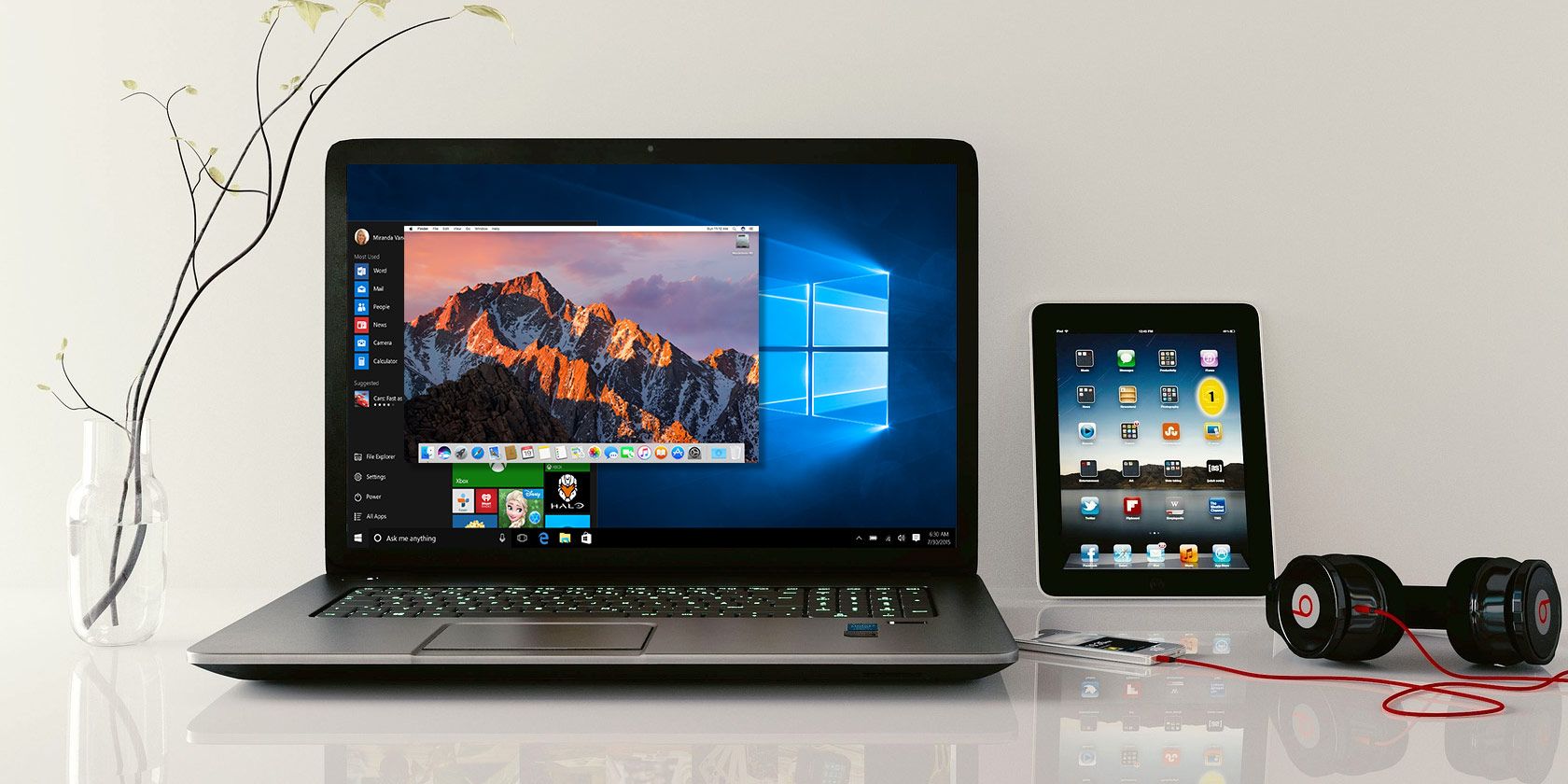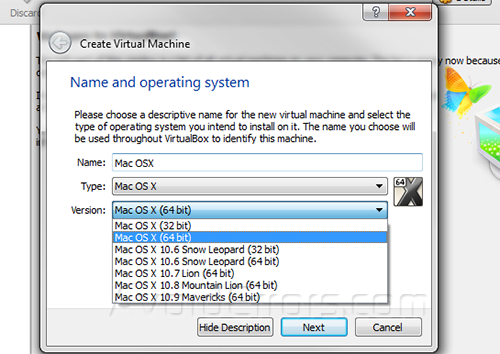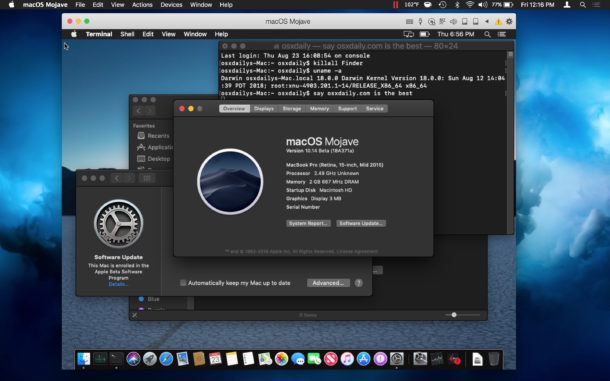You can install Mac OS X, OS X, or macOS in a virtual machine. Fusion creates the virtual machine, opens the operating system installation assistant, and installs VMware Tools. VMware Tools loads the drivers required to optimize a virtual machine's performance.
Mac OS X, OS X, or macOS virtual machines that you create in Fusion can run on any Apple-branded hardware that uses Intel processors. The Apple licensing agreement defines the situations when it is permissible to virtualize Mac OS X, OS X, or macOS. Fusion does not change these terms or enable macOS on non-Apple hardware. You cannot use a Mac OS X, OS X, or macOS virtual machine in another VMware product, such as Workstation Pro.
Fusion supports the following Mac server and client versions for the guest operating system:- Mac OS X Server 10.5, 10.6
- Mac OS X 10.7
- OS X 10.8, 10.9, 10.10, 10.11
- macOS 10.12, 10.13, 10.14, 10.15
- macOS 11.0
Fusion does not support the following features for Mac virtual machines:
- Easiest Way To Install Mac OS on a virtual machineThis is an updated and better version of my previous video on how to install Mac OS on Virtual Box.
- Snow Leopard Server specifically allowed installation in a VM. Normal Lion and Mountain Lion also allow installation in the VM in the EULA. Parallels and VMWare both support installation of Mac OS X guest machines for those versions. The EULA only allows it if the VMs are running on Apple hardware.
- Multiple displays
- 3D Accelerated graphics
- Unity view
Download and install the freshest version of VirtualBox for your OS. Launch VirtualBox and choose “New”. A special wizard will be started to help you to set up everything proplerly. Name your vertical machine as “OSX” and choose “Mac OS X” from OS menu, and “Mac OS X Server” from Version menu.
To install the operating system, use the procedure for creating a virtual machine for any supported operating system. See Create a Virtual Machine for Any Supported Operating System.
A lot of people who use Windows 10 as their Operating System on their PC or people who has not used any other Operating System except Windows want to try something new. There can be a thousands of reason to try a new Operating System like Ma. If your budget is good then you can buy a new Macbook from Apple company to try Mac OS but what if your budget is not well. In this tutorial of MAZHD, We will teach you how to install Apple’s mac OS Mojave on Windows on a VMware (virtual machine) and create a virtual Hackintosh.
Windows 10 is a great operating system, but it has its drawbacks. Even if you’re interested in Microsoft and Windows 10, you can still try other versions of the operating system from different companies. But what is a safer and cheaper way to use your favorite virtual machine system? This way you can run mac OS Mojave within Windows 10 on VMware (virtual machine).
What files do we need to install Mac OS in Windows 10 on VMware?
Before proceeding, you must download and install the necessary tools and files.
- Download the latest version of VirtualBox
- Download the latest version of VMware Player
This tutorial is on how to create mac OS virtual machines using both VirtualBox and VMware Player.
To get started, download VirtualBox and VMware Player from the links provided.
In addition to VirtualBox and VMware Player you also need a version of macOS. In this tutorial we have used the Mojave version. Note that this tutorial is currently only available on computers running Intel processors. So this tutorial will focus on installing macOS in a virtual machine on Intel hardware.
Download macOS image file
VirtualBox Intel HFS Mojave 10.14.3
- Google Drive
- Mediafire
- Code for VirtualBox
Virtualbox Intel APFS Mojave 10.14.3

- Google Drive
- Media Fire
- Code for VirtualBox

VMware Player Intel APFS Mojave 10.14.3
Google Drive
Media Fire
VMware Player Patch Tool
(The difference between Intel HFS and Intel APFS is in the file system type. APFS is the latest system file that was introduced in 2017)
After downloading the desired files, right-click on them and decompress them. For example, you can use the free 7Zip program to decompress files to get the file with the VMDK extension. The main file we use to build a virtual machine.
How to create a MacOS or Mac OS VMware (virtual machine) with VirtualBox?
To begin creating a Mac OS VMware, opening VirtualBox and select NEW. In the Name field, type MacOS so that VirtualBox automatically detects other specifications. Just note that in the version section, select the latest version of Apple’s operating system.
Then, you have to set the RAM value of the macOS virtual machine. The minimum amount of RAM selected is 4 GB, but you can set as much RAM as possible. Remember, you can’t allocate more RAM to your virtual machine than your main system, and the RAM distribution must be such that the main system running the virtual machine has no problems.
Finally, you need to select the Use an existing virtual hard disk file option from the hard disk section, and then enter the folder where you extracted the VMDK file in the pre-compressed stage.
Virtual Machine Settings for Running MacOS Mojave
Before starting a virtual machine, you need to make a few different settings on it.
- To start the settings, right-click on the built-in virtual machine and then select Settings.
Enter the System section and then disable the Floppy option from the boot order section. Then check that the settings for the Chipset section are on the ICH9 option.
Now go to the Processor section and assign the two cores to the virtual machine as shown below. If you use a powerful processor like the core i7, you can allocate more cores to a virtual machine. Finally, don’t forget to enable the “Enable PAE / NX” option.
In the Display section, set the Video Memory settings to 128 MB, and finally in the Storage section, be sure to enable the Use Host I / O Cache option.
Commands to Run Mac OS on a VMware (Virtual Machine)
Unfortunately, VirtualBox cannot run the macOS image file in the current configuration. Of course, there is no need to worry, because this problem can be solved with a few lines of code. Close VirtualBox completely to start over. Then search for cmd in the Windows 10 search section and Run it as Administrator.
The first code you need to enter after cmd is as follows.
Then enter the following commands line by line.
Finally, you can close cmd after seeing results like the one above.
Booting Mac OS Mojave in a VMware (Virtual Machine)
Now run VirtualBox again and start the virtual machine you created earlier.
After the start, long texrs will appear on the screen, and then for a minute or two, gray pages appear. You will then see a macOS welcome page.

You can now set the settings you want for the operating system to boot up.
Important Note: Once you’ve reached the welcome page, it’s a good idea to take a snapshot of this page so you don’t have to go back to the gray page if you have trouble running the system, or the wrong settings. And after installing and booting the system, get another snapshot that you can use to go directly to the same section. To get a snapshot in a virtual machine, enter the following path:
Machine> Take Snapshot
Do the mouse and keyboard not work?
A lot of time the mouse and keyboard do not work when the steps above are done. If the mouse and keyboard do not work for you after the above steps, you must download the virtual machine plugin.
After installing the plugin, open the virtual machine. From the Settings section, select the USB option, then select the USB 3.0 (xHCI) Controller option and click the ok button. Now use the mouse and keyboard without any problems.
Create a Mac OS Mojave machine on VMware Workstation Player
If you prefer VMware to VirtualBox, you can run a virtual machine with a few changes to VMware. Before we can create a virtual machine, we must first run the files to patch it.
To start patching from the download list at the beginning of the contract text, download the VMware Player Patch Tool from the VMware Player Intel APFS Mojave 10.14.3. Then go to the file download location and decompress the file. Then move the patch file to the folder where VMware is installed. Close the VMware software completely and right-click on the patch file and select Run as Administrator. Then a window will open and the patch operation will start. When the patch is complete, open VMware.
Remember that if you encounter the message File not Found, it is because the folder in which you copied the patch file has nothing to do with the main VMware folder. (VMware is installed on drive C by default)
Create a Mac OS Mojave Virtual Machine on VMware
After opening VMware, select Create a New Virtual Machine, and then I will install the operating system later. Now select Apple Mac OS X from the version. After selecting this option, you should be shown the Version to macOS 10.14 version. If you see a version other than the above version in the virtual machine, it means that the patch is not done well.
Now you need to choose a name for the virtual machine. We recommend macOS. After selecting the name, save a copy of the virtual machine installation path somewhere because in the next steps we need to do some editing on it.
In the next step, after determining the virtual hard disk, be sure to enable the Store virtual disk as a single file option. Note that after completing the settings in this step, do not run the virtual machine yet.
Change MacOS settings in Virtual Machine
Virtual Mac On Windows 10
Before starting the virtual machine, you need to set the hardware specifications and also specify the path of the macOS VMDK file.
On the VMware home screen, right-click on the name of the virtual machine you created, and set the hardware settings as the settings we taught in VirtualBox. It is best to have a minimum RAM of four gigabytes to achieve better results. In the Processors section, set the processing core settings to two. Now go to the Hard Disk (SATA) section and delete the hard drive created by the virtual machine. Then from the Add> Hard Disk> SATA (Recommended)> Use an existing disk section, select the virtual file of the macOS operating system specified by the VMDK extension.
Edit VMX File
Before proceeding with the final step, you must open the path that you have already saved and make changes to it.

The default path is as follows (for convenience, you can refer to the path you saved in the previous step).
When you enter the desired folder, you need to find the macOS.vmx file and open it with the Notepad. Go to the bottom of the file and type the following command at the bottom of the page and then save the file.
Install VMware Tools in Virtual Machine
If you remember, there was a file in the list of download files needed called VMware patch tool, which is a plugin for the correct operation of the mouse and keyboard and graphics settings. Follow these steps to enable this plugin:
Player> Removable Devices> CD / DVD (SATA)> Settings
Now from the Use ISO image file section, select the VM Tool New.ISO file that you downloaded earlier, and then click OK.
Now an icon called VMware Tools drive is added to your desktop. Double-click on it and then select Install VMware Tools. You will probably receive several security messages during the installation, which you must go to remove these messages:
Open Security Preferences> Allow
Now save all the changes and run the virtual machine.
Problems You may Encounter
Moreover, you will probably have problems installing and running Mac OS on a VMware (virtual machine).
- If the virtual machine does not run, you may need to review the settings and patch files again.
- If you encounter the message “Mac OS X is not supported with binary translation”. You must enable the virtualization option from the BIOS / UEFI settings section.
- If you encounter a “(VMware Player unrecoverable error: (vcpu-0”) warning during run, you should check if the macOS.vmx file has been edited properly.
Finally, it is important to note that the use of any operating system in a virtual machine under any circumstances cannot convey to the user the actual experience of working with that operating system in real hardware.
Install Macos Virtual Machine Windows 7
Related Searches:
- mac os mojave vmware download
- mac os mojave vmware image download
- how to install mac os on vmware workstation 15
- mac os mojave iso download for virtualbox
- vmware macos unlocker
- macos mojave vmware image
- mac os mojave iso google drive
- macos mojave iso download
- install mojave on virtualbox on mac
- mac os mojave vmware image download
- macos mojave virtualbox image
- mac os iso download for virtualbox
- macos mojave iso download
- mac os mojave iso download for vmware
- how to install mac os on vmware workstation 15
- mac os mojave vmware download
- mac os mojave iso google drive
- how to install mac os on vmware workstation 14
- mac os sierra vmware image download
- macos catalina vmware
- install macos catalina on vmware
- mac os high sierra vmware image download
- macos mojave vmware
- vmware macos catalina
- macos vmware image
- vmware player
- mac os for vmware
- mac os in vmware
- vmware, macos download
- mac os on vmware
- mac os vmware
- macos vmware
- vmware mac os
- macos on vmware
- vmware for macos
- macos mojave iso
- mac os in vmware
- mac os x vmware
- how to install mac os on vmware
- mac os vmware install
- vmware macos
- mac os on vmware workstation
- mac os vmware image
- how to install macos on vmware workstation 15
- mac os on vmware player
- mac os sierra vmware image download
Install Mac On Virtual Machine
This way you can install Mac OS Mojave or any other Mac OS on VMware (Virtual Machine). We hope that this artile can help you. If you have any Question regarding of this article you can leave a comment down below in the comment section.
Install Ubuntu On Mac Virtual Machine
Source:Zoomit
Windows Virtual Machine Mac

Related
